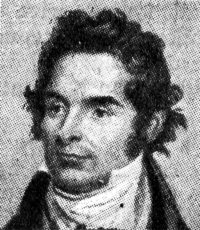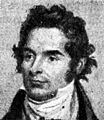William Scoresby facts for kids
Quick facts for kids
William Scoresby
FRS FRSE
|
|
|---|---|
 |
|
| Born | 5 October 1789 Cropton, Yorkshire, England
|
| Died | 21 March 1857 (aged 67) Torquay, Devon, England
|
| Alma mater | |
| Known for | Arctic exploration |
William Scoresby (born October 5, 1789 – died March 21, 1857) was an amazing English explorer, scientist, and church leader. He was also a whaler who sailed to the Arctic. He made many important discoveries about the polar regions.
Contents
William Scoresby's Early Life and Voyages
William Scoresby was born in a small village called Cropton in Yorkshire, England. His father, also named William Scoresby, was a very successful whaler. He even invented the crow's nest, a special barrel at the top of a ship's mast. This allowed sailors to see far across the ocean.
Young William first sailed with his father when he was just eleven years old. After that, he went back to school until 1803.
Later, he became his father's main helper on the whaling ship Resolution. In 1806, they reached a very high northern point in the Arctic. This was the furthest north anyone had gone in that part of the world for 21 years! During the winters, Scoresby studied science at Edinburgh University.
Scoresby's Scientific Discoveries
In 1807, Scoresby started to study the weather and nature of the Arctic. He made important observations about snow and ice crystals. In 1809, he became a member of the Wernerian Society in Edinburgh because of his Arctic papers.
In 1811, Scoresby took over command of the Resolution from his father. He also got married that same year. On a voyage in 1813, he discovered something new about the polar ocean. He found that deep under the surface, the water was warmer than the water on top.
Scoresby was always eager to learn more about science during his whaling trips. His letters to Sir Joseph Banks helped spark interest in finding the Northwest Passage. This was a sea route connecting the Atlantic and Pacific oceans through the Arctic.
In 1816, Scoresby faced a big problem when ice damaged his ship, the Esk. With help from another ship, they fixed it. He wrote about this adventure in his 1820 book, The Northern Whale-Fishery.
In 1819, Scoresby became a member of the Royal Society of Edinburgh. He also wrote a paper about how a compass needle acts strangely near the North Pole. In 1820, he published An Account of the Arctic Regions and Northern Whale Fishery. This book shared all his own observations and those of other explorers.
In 1821, he sailed to Greenland with George Manby. Manby wanted to test a new type of harpoon for hunting whales. Scoresby's 1822 voyage to Greenland was his last to the Arctic. He mapped about 400 miles of the east coast of Greenland. This gave the world its first real maps of that area.
When he returned, he learned that his wife had passed away. This sad event, along with his strong faith, led him to become a church leader.
Scoresby's book, Journal of a Voyage to the Northern Whale Fishery, came out in 1823. In 1824, he became a member of the Royal Society. He also joined the French Academy of Sciences in Paris in 1827.
Scoresby was an active member of the British Association for the Advancement of Science. He especially helped us understand more about Earth's magnetism. He wrote many papers on this topic. He also studied light and worked with James Joule to compare different types of power.
To learn more about magnetism, he sailed to Australia in 1856. He wrote about his findings in a book published after his death. He also visited America twice and studied the height of waves in the Atlantic Ocean. Scoresby also cared a lot about social issues, like making factory workers' lives better.
In 1850, Scoresby wrote a book encouraging the search for the Franklin expedition. This was a group of explorers who went missing in the Arctic.
Scoresby's Life as a Clergyman
After his time as an explorer, Scoresby began studying to become a church leader at Queens' College, Cambridge. He became a curate, which is a type of assistant priest, in Yorkshire. In 1834, he earned his degree in Divinity. He later received an honorary doctorate in 1839.
Even with his church duties, Scoresby kept his interest in science. He worked in churches in different cities like Liverpool, Exeter, and Bradford. He also wrote many books and papers about religion.
From 1839 to 1846, Scoresby was the vicar of Bradford, Yorkshire. This was a very large and busy industrial town. He worked hard to improve the church's organization. However, he faced some disagreements with others in the church. He tried to divide the large parish into smaller ones, but he was not successful.
Scoresby's health suffered, and he resigned from his position in 1846. He then traveled to the United States to study industrial conditions there. After this, he did not take on any more permanent church jobs.
Personal Life and Legacy
Scoresby was married three times. After his third marriage in 1849, he built a house in Torquay. He became an honorary lecturer at a local church there.
William Scoresby passed away in Torquay on March 21, 1857. He is buried in the churchyard at Upton, Torquay. His memorial has a compass, dividers, and a Bible carved on it. He is also remembered on his family's grave in Whitby.
Many places around the world are named after William Scoresby, honoring his important contributions:
- The Lunar crater Scoresby on the Moon.
- Scoresbysund, which is now called Ittoqqortoormiit, on the east coast of Greenland.
- The large Scoresby Sund fjord system in Greenland.
- The Melbourne suburb of Scoresby, Victoria in Australia.
- The RRS William Scoresby, a research vessel.
- William Scoresby Bay and the William Scoresby Archipelago off the coast of Antarctica.
- Scoresby Land in Greenland.
- Cape Scoresby, a bluff near Borradaile Island.
- Scoresbyøya, a small island in Norway.
Images for kids
See also
 In Spanish: William Scoresby para niños
In Spanish: William Scoresby para niños


